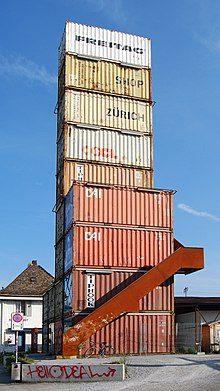Mobile architecture
Mobile architecture refers to architecture concepts that deal with the mobility of structures. A distinction can be made between movable and modular structures. There is a close relationship to temporary architecture , whereby relocation and re-use need not be the foreground.
differentiation
Movable structures

In the case of the movable structures, these are preserved as a whole and their complete mobility is in the foreground. So the whole body is mobile and its internal and external structure is not changed. An example of this are above all floating structures , such as the exhibition building for the IBA Hamburg shown in the figure opposite. The structure resting on a pontoon can be moved across the water to a new location without any structural changes. The ViewPoint in Hamburg's HafenCity is an example of land transport . This is a lookout tower for visitors. This serves to illustrate the progress of construction on this major urban development project or to be able to take a look at the construction sites. Due to the ongoing development and the resulting relocation of construction activity, it has already been moved to new locations several times.
Modular structures
The second group are the modular structures. Their mobility is ensured by the fact that the structure can be dismantled into individual components. These can then be transported separately to a new location. Mobility requires a smooth and quick assembly and disassembly process. The individual modules and elements are often designed in such a way that they can be rebuilt many times, even in different combinations. It is precisely this flexibility that makes the structures adaptable to the individual circumstances of the respective locations. Containers are best suited for this , as their shell is designed for easy and quick transport and at the same time they have a large amount of space inside. But they can be used for completely different purposes. The so-called Nomadic Museum housed an exhibition that was shown in several locations around the world. The requirement was to ensure constant assembly and dismantling at different locations. The containers primarily served as the outer walls of the two exhibition rooms. This was combined with a roof and additional side elements to separate the interior from the outside. A second example is the 4th grammar school in Amsterdam. As a temporary structure, it is used to supply school places in a port area geared towards future urban development. The current location borders on the nearby residential development, but the later development of this area is intended to be used for residential construction. The entire building with classrooms and teachers' rooms as well as common areas is made entirely of containers. When the school is abandoned at this location, the containers can be set up again in a different arrangement at another location for the same purpose. This also applies to a neighboring student residence.
transport
The way from one usage location to the next can be covered in many ways. In the past the structures were moved manually or with the help of beasts of burden, today this task is carried out by trucks , trains and ships. Transport by air with cargo helicopters is also possible, but very expensive. Most of the transport tasks are carried out by the trucks, as this type of change of location is very flexible and inexpensive.
construction
The construction of mobile architecture is often very simple, but still resilient and durable. As building materials all lightweight materials are used, ie steel , plastic , wood , corrugated iron and materials of all kinds. Traditional building materials such as concrete , brick or glass are too heavy or are not suitable for frequent transports. Mobile buildings are only built on small foundations or can even do without a foundation. In this case, they are secured in place with a light anchor.
See also
- Flying construction : construction law term for structures that are suitable and intended to be repeatedly erected and dismantled
- Building relocation , relocation (monument preservation)
- Construction that can be dismantled : Recycling of modular buildings
literature
- Axel Dossmann, Jan Wenzel, Kai Wenzel: Temporary architecture. Barracks, pavilions, containers. b_books, Berlin 2006, ISBN 3-933557-66-6 .
- Markus Heinsdorff: Mobile Spaces - Textile Buildings . Jovis Verlag, Berlin 2014, ISBN 978-3-86859-295-5
- Matthias Ludwig: Mobile architecture. History and development of transportable and modular buildings. German Verl.-anst., Stuttgart 1998, ISBN 3-421-03140-1 .



